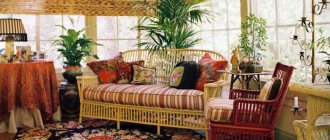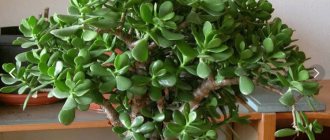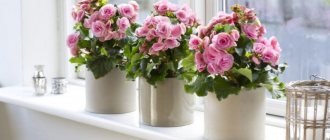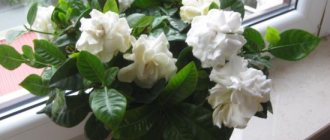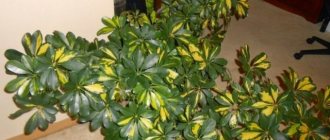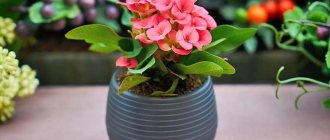The Age of Great Geographical Discovery is a period thanks to which the concept of “houseplants” appeared, which allowed green pets to decorate a person’s home for centuries and delight him with the unusual appearance and beauty of inflorescences. Today, plants grown in pots and greenhouses decorate not only home windowsills. Indoor flowers at school are not only an obligatory element of landscaping, but an important component of the aesthetic education of children, their activity, physical and mental.
The benefits of landscaping in schools
- Very high noise levels, especially during breaks, are a big problem in school life. Plants can contribute to noise reduction and create acoustic comfort indoors. For subjective improvement of well-being, sound absorption, assessed by the average in the frequency range 250-4000 Hz, is of great importance. Scientists from the Educational and Experimental Institute of Horticulture in Essen have proven that it is in this frequency range that plants effectively suppress noise. So, for example, in a room of 30 m2 there are ten specimens of Ficus Benjamin, approx. 1.80 m can absorb up to 25% of noise. If we compare the soundproofing properties of ficus and curtains, then three ficus equals 5 m2 of curtains. Research has shown that decorating classrooms with plants plays not only an aesthetic role, but also a lesser-known sound-absorbing role.
- It is during the winter period that low air humidity in heated rooms can cause health problems for both students and teachers. As measurements have shown, air humidity in classrooms from October to March is 15-30%, while the optimal level should be 40-65%. In classrooms where there is a lot of talking, it is the influence of dry air that has a particularly strong impact on children’s well-being. When you inhale dry air, the mucous membrane of the nose and throat dries out and no longer retains viruses and bacteria. As a result, there is an increased susceptibility to disease, and some experience symptoms of allergies and asthma. Plants are able to evaporate up to 97% of moisture. Thus, non-flowering ornamental plants with a very high transpiration rate, such as nephrolepis, fatsia, cyperus, ficus, dracaena, hibiscus, create a comfortable level of humidity in the rooms in winter. ... on air quality.
- Scientists have been talking about the effect of plants on reducing harmful substances contained in indoor air since the 80s. Thus, Dr. Wolverton, as part of a NASA program to maintain clean air in closed life support systems, proved that some plants are able to filter the air, thereby improving its quality. Many volatile organic substances, such as formaldehyde, acetone, toluene, etc., from furniture and building materials enter the indoor air and can cause headaches, allergies, and skin rashes in humans.
What flowers cannot be placed
Along with useful ones, there are also plants that are harmful to schoolchildren. They are, of course, conditionally harmful. But in a children's group, the main thing is safety, so you need to approach the selection of colors carefully.
What plants are best not to be placed in a school classroom and why?
1. Poisonous plants - cause serious and dangerous symptoms of poisoning, mucosal damage, inflammation of the stomach and intestines, swelling, convulsions, nausea and vomiting. This effect can occur through skin contact or eating poisonous parts of the plant.
- Agave, some types of aloe
- Aglaonema
- Azalea
- Alocasia
- Anthurium, Spathiphyllum
- Amaryllis
- Dieffenbachia
- Croton
- Euphorbia cypress
- Monstera, Philodendron (often recommended for office growing as a shade-tolerant plant)
- Pachypodeum
- Ficus
- Cyclamen
- Yucca
Photo: aglaonema
2. Strong-smelling aromatic plants release essential oils and can cause severe headaches and cause asthma attacks.
- Geranium (pelargonium)
- Lilies
- Oleander
3. Thorny plants, which can cause wounds and pain upon contact
- Cacti and some types of succulents
4. Plants with berries can cause poisoning if they eat poisonous fruits that are beautiful and attractive to children.
- Asparagus is often grown in offices, but it is not allowed in children's institutions due to its poisonous berries.
- Nightshade
Care should be taken to keep citrus plants in the institution, which can cause allergies and dermatitis. You should also avoid plants that accumulate a lot of dust (for example, violet leaves with “fluff”). “Dust collectors” can cause attacks of allergies and asthma, and healthy children do not need to breathe dust.
Photo: Nerium oleander
Choosing a plant for a school office
A wide variety of plants can be placed in school classrooms. It all depends on the wishes of the class and the teacher.
Pelargonium royal: home care, photo
Mallow planting and care in open ground
Planting and caring for cornflowers in open ground
- Decorative foliage and flowering plants can be placed on window sills and flower racks. Look good in the classroom: Tradescantia, Dracaena, Crassula, Selaginella, Abutilon, Ginura, Impatiens, Saintpaulia, Pelargonium and other relatively unpretentious flowers.
- Ampelous (tradescantia, chlorophytum, philodendron, asparagus sprenger) and vines (cissus, ivy, scindapsus) are placed in special wall planters or wall boxes. Support for climbing stems can be a fishing line, a stretched rope, a trellis, or branches. Such devices look organic and do not interfere with the movement of schoolchildren.
- Succulents (cacti, agave, aloe, sansevieria, haworthia) look beautiful in special flower slides. You can buy them in the store or make them yourself. To do this, you will have to show your imagination; you can use large boxes, fill them with sand and stones, thereby simulating a desert landscape.
For clarity, plants can be divided into groups according to origin (habitat) or families. Hang signs on each plant or keep a file cabinet.
Where can you put flowers in a school office?
When choosing flowers for school, keep in mind that they should be shade-tolerant and easily withstand a lack of light. The fact is that, according to sanitary standards, it is forbidden to place flowers in offices on window sills so that they do not interfere with sunlight, and on furniture so that the pots do not fall.
Therefore, it is best to provide special multi-level stands. The flowers will look good on the wall opposite the window. It is important to securely attach and install any planters so that the inspection (which happens quite often at school) goes smoothly.
Decorative - foliage flowers for the school office
Haworthia . Haworthia belongs to the Xanthoreaceae family. Her homeland is South Africa. This unpretentious succulent has become widespread among indoor plant lovers.
Chrysalidocarpus . Chrysalidocarpus belongs to the Palm family (Arecaceae). Homeland: Comoros and Madagascar. Like all palm trees, it is grown as an ornamental foliage plant. Growth form: single- or multi-stemmed rosette trees.
Pomegranate . Pomegranate belongs to the Garnet family. Naturally grows in subtropical areas of the Mediterranean and Asia.
Plectranthus. Plectranthus belongs to the Lamiaceae family. Naturally grows in Africa, Asia, Australia and the Pacific Islands. In terms of growth form, they are creeping herbs, but some species grow like shrubs.
Syngonium. Syngonium belongs to the Araceae family. The homeland of this decorative foliage plant is Central and South America. It is a climbing vine.
Choosing plants for the class
When wondering what flowers you can grow at school, select plants from one of the following groups.
Decorative foliage
Beautiful plants with original shapes and leaf colors will transform any office. Will fit into the classroom interior:
- aspidistras, which do well in the shade;
- dracaenas and ginurs, which purify the air from harmful substances;
- fat women, attractive for their originality;
- Sansevieria, undemanding and unpretentious.
Beautifully flowering
But in addition to useful plants, you also want beautiful ones; representatives of beautifully flowering plants will become a real decoration:
- cheerful balsams,
- delicate multi-colored Saintpaulias, which we more often call simply violets,
- pelargoniums, not only pleasing to the eye, but at the same time having a bactericidal effect.
Ampelous
Hanging hanging plants are ideal for decorating walls and partitions between windows:
- chlorophytums, combining decorative properties with disinfecting functions,
- scindapsus with shiny glossy leaves;
- burgundy ginurs,
- traditional tradescantia,
- evergreen philodendrons.
Curly
Climbing plants can also be placed in classrooms:
- ivy, which is especially loved by all gardeners because of its unpretentiousness,
- openwork asparagus, performing the important mission of purifying the air in the classroom.
Bulbous and tuberous
Bulbous and tuberous flowers in the classroom and at school will be able to please young flower growers and their mentors with bright blooms:
- spectacular hippeastrums,
- colorful gloxiñas.
Of course, you should not place all the flowers from this list in one room. A sense of proportion will tell you how many plants will fit well into the interior of the classroom, leaving the main space of the room to its owners - the students and their teacher.
Video “Indoor flowers at school - choosing the right one”
Ampel flowers for the school office
Flowering ampelous plants are considered the most spectacular, but there are many ampelous plants with beautiful greenery. The names of the most common “dangling” flowers are presented below:
- Begonia is known to everyone. This flower is colored coral or red and looks like a small chrysanthemum. Ampelous begonia can be placed in a flowerpot, hanging flowerpot or in a window box.
- Pelargonium is better known as geranium. There are many varieties of this variety, with different inflorescences and shades. Pelargonium is one of the most unpretentious ampels; it can withstand strong winds, heat and long-term lack of watering.
- Lobelia will decorate both the sunny and shaded parts of the window. But this ampel needs nutritious soil; it does not grow in loams and sandstones. Another important point is regular watering.
- Dichondra is one of the green plants that does not have flowers. Dichondra lashes reach a length of one and a half meters. It is used to cover paths and fill the space between tiles or stones.
Green pets: what are they?
Chlorophytum, a plant characterized by its ease of care
An indoor flower grown in special conditions combines many positive characteristics. He is the source:
- bright colors;
- lush foliage;
- unusual inflorescences;
- fantastic patterns;
- refined forms.
In addition, it is worth noting the ability of some plants:
- absorb excess carbon dioxide, which leads to the saturation of air masses in enclosed spaces with oxygen (rosemary, pelargonium);
- fight pathogenic microbes (begonia, cyperus, small-flowered chrysanthemum);
- delight with delicious fruits (pomegranate, pineapple, lemon, banana, tangerine, etc.);
- heal;
- help in educating the younger generation.
Indoor plants not only create coziness and instill in children a reverent attitude towards nature, but also bring benefits, improving the atmosphere of school premises. Plants in school play not only an aesthetic and educational role, but also an educational role. Many of them can serve as a visual aid in biology and geography lessons, being representatives of the vegetation of the tropics and subtropics.
Plants purify indoor air from toxic substances released by plastic coverings, synthetic resins, increase air humidity, kill bacteria and reduce electromagnetic radiation. Therefore, if you want your children to study in a clean classroom, furnish the classroom with useful plants. For landscaping In classrooms in schools, it is recommended to use unpretentious tropical plants: monstera, hibiscus (Chinese rose), sensevieria, asparagus, chlorophytum, palm trees, cyperus, etc. We present to your attention the ten most popular plants used in landscaping school premises.
Chlorophytum is an unpretentious, highly decorative indoor plant, which is one of the best air purifiers. Several of these plants are enough to absorb the formaldehyde released by thermal insulation from synthetic materials in a medium-sized class. Chlorophytum also has a significant bactericidal effect. Sansevieria - in addition to its cleansing functions (removes benzene, formaldehyde and trichlorethylene), also has the ability to increase the adaptogenic properties of the body, helping it resist viral diseases. Scindapsus purifies the air from formaldehyde, carbon monoxide and benzene. In addition, this fast-growing vine perfectly decorates walls with its shiny glossy leaves. Hibiscus (Chinese rose) is ideal for landscaping spacious, bright rooms - school lobbies, corridors, assembly halls. Dracaena is tolerant of a lack of light, so it can be used for landscaping classrooms, even located in the back of the room. Absorbs and neutralizes harmful substances from the air: benzene, formaldehyde, carbon monoxide. Begonia is represented by both decorative foliage species and beautifully flowering plants that are attractive throughout the whole year. According to the teachings of Feng Shui, the presence of begonias in a room helps to build character and achieve success. Monstera is a beautiful plant for decorating spacious school lobbies and corridors. Purifies the air and increases air humidity. Asparagus is an openwork, unpretentious plant, suitable for landscaping bright classrooms. Cleans the air from harmful impurities. Pelargonium is famous for its bactericidal properties, thanks to the essential oils contained in its leaves; its aroma has a beneficial effect on the nervous system. Spathiphyllum is a beautiful plant that does not require complex care and tolerates lack of lighting. Cleans the room from harmful gas impurities. Other widespread plants that are effective air purifiers and also release biologically active substances that kill staphylococci and streptococci are geranium, ficus, dieffenbachia, cacti, ivy, many types of palms (date, areca, bamboo palms, tall rapis), etc. Consultants of the “Your Garden” store will help you choose the most suitable plants for the classroom and other school premises.
“Your Garden” Publication date 09/05/2014
